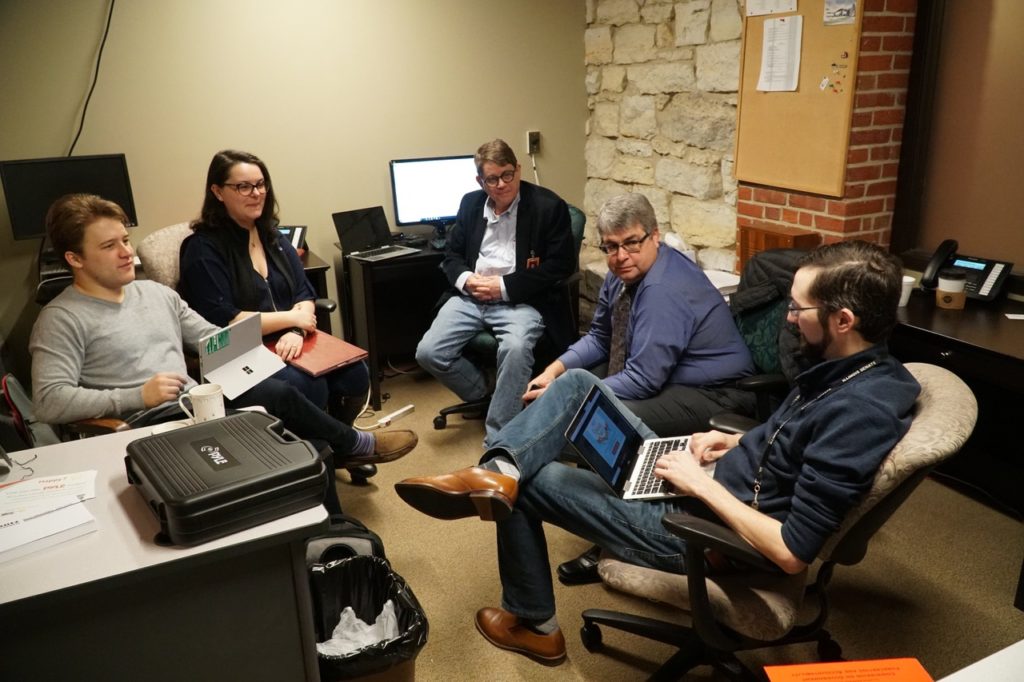New statehouse bureau aims to fill gap in coverage for Illinois newspapers
Like many statehouse press corps, the one in Illinois is a fraction of what it used to be. Since the legislative session started this year, about a dozen reporters, including interns, have been assigned to cover what’s going on in the Illinois capital. A decade ago, there were 30 full-time statehouse press reporters in Springfield and even more on session days.
It’s loss that is lamented and felt in nearly every newsroom in Illinois, from the smallest weeklies to the major daily newspapers in Chicago. Even the capital-city paper hasn’t been spared. On May 10, Angie Muhs, the executive editor of the State Journal-Register, resigned, leaving the Springfield paper without a top editor. The newspaper, owned by Gatehouse Media, already had laid off its photo and sports editors. It now has just six news reporters.
Jeff Rogers tried hard to figure out how to address this gap in state government coverage when he was editor of the Sterling Telegraph and Daily Gazette in northern Illinois. But he couldn’t make the math work. His two biggests costs at the Shaw Media publications he edited were personnel and newsprint, and he was already stretched thin.
Now he has.
Rogers is the inaugural bureau chief of the new Capitol News Illinois, an initiative of the Illinois Press Foundation, the charitable arm of the Illinois Press Association. The service, which launched on Jan. 28, provides free statehouse coverage to its more than 400 members. Including Rogers, there are four full-time staff members at the bureau, as well as two interns from the public affairs journalism program at the University of Illinois at Springfield.

(Photo by Lee Milner of Illinois Times)
“I am thrilled to have this new service,” said Jeannette Brickner, executive editor of the Times New Group in Central Illinois, which publishes papers the Pekin Daily Times, Chillicothe Times-Bulletin, East Peoria Times-Courier,, Morton Times-News, Washington Times-Reporter and Woodford Times. “In today’s times with very small newsroom staffs, we need all of the help we can get. We do use Associated Press stories, but Capitol News really focuses on what’s going on in our state regarding politics and more. These are the stories that will resonate with our readers, and the Capitol News team is producing a good amount and variety.”
Since its launch, more than 300 Illinois papers have published Capitol News Illinois content (nearly 7,000 stories), including the Chicago Sun-Times and suburban Daily Herald. Of those, 255 were weeklies, publications that historically have never had much, if any, statehouse coverage, said Sam R. Fisher, president and chief executive of the Illinois Press Association. “The good thing is that weeklies are running this content,” Fisher said. “We didn’t know the extent the weeklies would embrace this. That is content that is being delivered to readers who haven’t seen that kind of state content before.”
Readers of the Springfield paper were used to that kind of comprehensive coverage of state government. But it is now stretched too thin and it shares its statehouse reporter with other papers in the Gatehouse chain. The Journal-Register has published dozens of stories from the Capital News Illinois bureau, including articles on health care reform, funding for state colleges and universities and sports gambling.
John Homan, managing editor of the Southern Illinois Local Media Group, which publishes the Marion Republican and the Du Quoin Call, said he has welcomed the state news coverage.
“While I have never supported national news in small publications like ours, state news not only helps us fill space but informs,” said Homan, whose papers have published stories on proposed legislation to remove toxic coal ash pits and renewable energy. “It’s relevant because it’s our state.”
The bureau has mostly focused on committee hearings and proposed legislation before it makes it to the floor for a vote, Rogers said. Recent stories included coverage of a proposal to legalize sports betting and a bill to ban for-profit immigration detention centers. The bureau also covered a brief visit to the capitol grounds by Stormy Daniels, the adult entertainment star who said she had an affair with President Trump. Daniels, whose legal name is Stephanie Clifford, joined a group of demonstrators in March to protest the “pole tax” on adult entertainment venues.
“Too often, local readers focus on just their community and don’t pay attention to what’s happening even in the next city over sometimes,” said Tim Rosenberger, managing editor of the Pekin Daily Times. “For them to know what’s going on in their state capitol — what laws are being passed, what’s being considered, and the general direction their state is going in — is crucial, because what’s happening there will affect them. So, I enjoy giving readers a look at all the big and small things going on in Springfield.”
Rosenberger said he usually run stories that will impact his Central Illinois readers in some way. “I didn’t use a recent Capitol News story that I believe had to do with the Chicago school board, because that doesn’t really affect people here,” he said. “But I will include stories about voting and smoking age, college and health policy, immigration, etc. Those are the types of stories that are relevant to them.”
The news bureau staff shares office space with the Daily Law Bulletin and Illinois Times in the basement of the capitol building. The space is overseen by the Illinois Correspondents Association.
Capitol News Illinois has provided its coverage even though its reporters were denied press credentials from both the Illinois House and Senate because the Illinois Press Association is a registered lobbying organization. That doesn’t mean the bureau cannot cover the statehouse, but it’s harder to do so without official credentials.
Illinois is hardly the only state with fewer reporters on the statehouse beat. A Pew Center research study five years ago found that less than a third of all U.S. newspapers assigned a reporter, full-time or part-time, to their statehouse. Nearly 90 percent of local TV stations did not assign anyone. It’s undoubtedly even fewer today.
Rogers is hopeful that the bureau could ultimately serve as a model for other state press associations.
“It was relatively easy to set up and relatively inexpensive,” he said. “We’re able to do all of this. It’s really a cost-effective. The need that’s here in Illinois is everywhere.”
A version of this story first appeared in Publisher’s Auxiliary, the only national publication serving America’s community newspapers. It is published by the National Newspaper Association. GJR is partnering with Pub Aux to re-print Jackie Spinner’s monthly “Local Matters” column on our website. Spinner is the editor of Gateway Journalism Review. Follow her on Twitter @jackiespinner.


